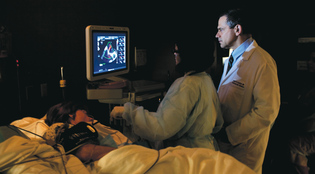 loading
loading
featuresThe heart of the matterCardiologist Harlan Krumholz is diagnosing what works and what doesn’t. His patient: the American health care system. Carole Bass ’83, ’97MSL, is senior writer at the Yale Alumni Magazine.  Mark OstowCardiologist Harlan Krumholz ’80 and colleagues study an ultrasound image of a patient's heart. Krumholz's research is on improving medical practices and outcomes, but he still sees patients one morning a week. View full image
Lesson 1: bedside manner In a dimly lit room in Yale–New Haven Hospital’s echocardiography lab, a round-faced woman in her late 60s awaits her latest medical procedure. Admitted to the hospital for heart failure, she has undergone ten days of tests and drugs and needles. Cardiologist Harlan Krumholz ’80 approaches the bed, dressed in his typical out-of-the-office attire: blue shirt and khakis, no white coat. Krumholz, who is also a professor at the Yale School of Medicine, chats with the patient about her symptoms, her husband, her children. “It’s good you’re here, because now we can give you the medicine that can help you,” he tells her. The doctors want to snake a probe down her throat and behind her heart, a procedure called a trans-esophageal echocardiogram, in hopes of discovering what’s causing a valve to leak. But the first round of sedative—a low dose, which Krumholz prescribes because more could be risky for a patient in her condition—doesn’t allow her to swallow the thumb-width black probe. She gags and coughs, and Krumholz directs the young cardiologist administering the procedure to stop. “You’re in charge,” Krumholz tells the patient. After a second dose of sedative, he holds her hand as the young doctor tries again. Again, the patient starts to gag. “You’re so close!” Krumholz exclaims. “Can you give me one swallow?” She can’t, so they give her yet a little more sedative. “I’m so sorry,” Krumholz tells her. “We’re going to try one more time.” Taking the probe in his left hand, he demonstrates to the other doctor how to angle it “so it’s really a straight shot.” Then, so deftly that I barely notice he has taken over, Krumholz successfully inserts the probe. “Whoa, you did so well!” he tells the patient. “Beautiful job. That’s the hardest part.”
Lesson 2: what they don’t teach in medical school On the last day of February, Krumholz convenes his regular weekly meeting with postdocs in the Robert Wood Johnson Clinical Scholars Program. These are MDs who have finished their residencies and—instead of heading out to practice—have opted for two years of training as “health leaders.” In the elevator on the way up, Krumholz lists some things that bright young doctors like these didn’t learn in medical school. “They don’t know anything about policy,” he says. “They don’t know anything about payment systems, about how organizations work. They don’t learn about how to get things done.” The two-year Clinical Scholars Program, which Krumholz has directed since 1996, teaches these subjects and more: framing research projects, partnering with community organizations, critically analyzing scientific literature. Addressing a group of applicants to the program on a different day, Krumholz describes what he wants from their research: “Tell me what problem you’re trying to solve. I don’t want to hear ‘Well, I think this can get published.’” At 7:30 on a Monday morning, with freezing rain falling against the windows and no coffee in sight, Krumholz quizzes the scholars on an “extraordinarily important” yet neglected study of how flawed cardiac imaging causes some patients to receive unnecessary procedures, while others don’t get the treatment they need. He invites their feedback on an article he’s drafted. And he urges them to think about “economic value”—“As far as I can see, for the next 10 or 15 years you’re going to have to pay attention to it”—and on hospital readmission rates, which he calls one of the most important health care issues in America today. Krumholz wants to impress on the scholars that the overriding goal is not to publish in prestigious journals (although he has published in plenty) nor to gain a fancy title (though Krumholz is the Harold H. Hines Jr. Professor of Medicine for cardiology; a professor of investigative medicine and of public health; and an editor of publications for the New England Journal of Medicine’s publisher and the American Heart Association). Nor is the goal to hone clinical skills, despite Krumholz’s finesse with the trans-esophageal probe. As a child, he loved accompanying his pulmonologist father on hospital rounds, but now he sees patients only one morning a week. Rather, Krumholz’s main project, as director of Yale–New Haven Hospital’s Center for Outcomes Research and Evaluation (CORE), is “to get things done.”
Lesson 3: “what’s your shtick?” Working in the emerging field of outcomes research, Krumholz and CORE focus on figuring out, first, what works for real patients in the real world, and then, how to get it to them. Last year, Forbes called him “the most powerful doctor you never heard of.” A mild-mannered revolutionary in Merrell mocs, Krumholz is trying to do for health care what Bill James (of Moneyball fame) has done for major league baseball: asking the right questions and collecting the right data to uncover patterns in the real world, then using that analysis to improve performance. The scope of his work is daunting. He spearheaded a national campaign that has dramatically sped up treatment time for heart attack patients. He helped expose deceptive, sometimes deadly drug-industry practices. Working with Medicare, he has developed ways to measure the quality of hospital care, pushed to make the results public, and helped to craft incentives for better care. And those are just some of his projects in the past half-decade.
|
|